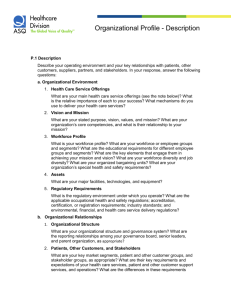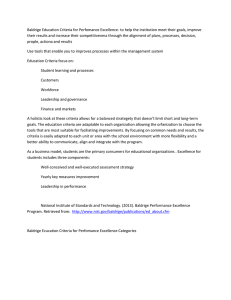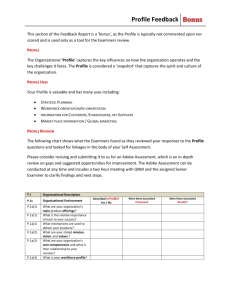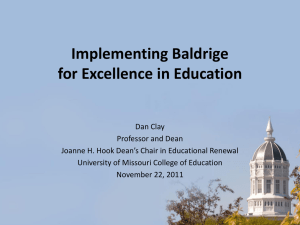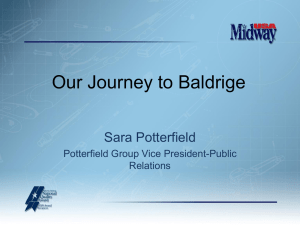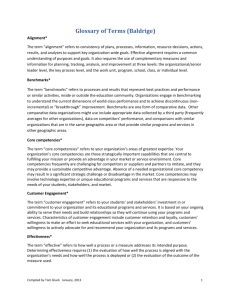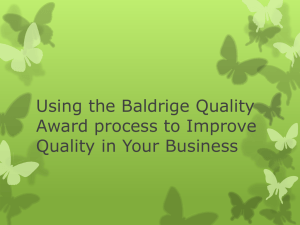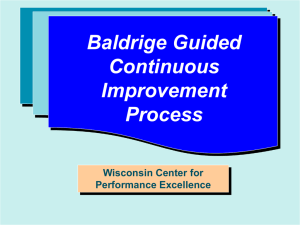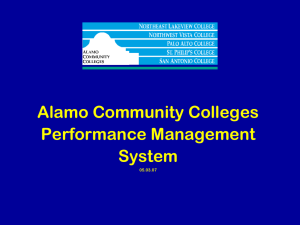Education Beginner Level Criteria
advertisement
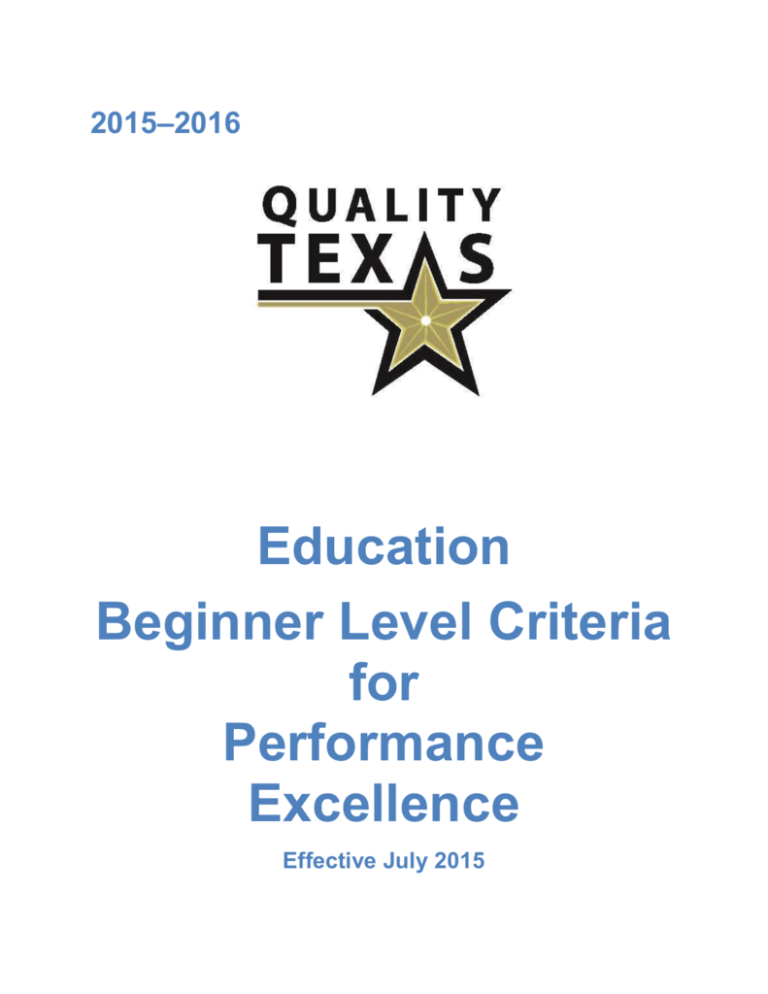
2015–2016 Education Beginner Level Criteria for Performance Excellence Effective July 2015 Note from the CEO: Thank you for taking the time to consider applying for the Quality Texas Foundation Beginner Level of Recognition (five page Organizational Profile). This is the starting point for your organization or a section/group within an organization. Your next step is our Engagement Level of Recognition (five page Organizational Profile + 10 page application). Since this is probably your first entry with Quality Texas Foundation, welcome aboard. It is our sincere hope that the questions embedded in the five page organizational profile will cause your organization to evaluate exactly where you are, where you should be, and how you can significantly improve by prioritization of your improvement steps. The Baldrige Framework is used the world over to make systematic improvements to organizations. Proposed steps are shown below. 1) Assign a minimum of two personnel in your office to become Examiner trained with the Quality Texas Foundation. This training is where we actually teach the Examiner how to write the responses to the questions and the reasons behind the questions. You can just begin writing if you like, but past information received from applicants indicate the Examiner training was a major milestone in writing at any level. 2) Write your responses and allow other people in your office to edit your work. Don’t fall in love with your first draft. This application to be really effective will undergo several iterations with substantial improvements along the way. The application process will allow the organization to ask very difficult questions and address organizational priorities. 3) Revise multiple times and submit. If we here at the Quality Texas Foundation can be of assistance to you, please allow us that opportunity. We offer coaching and training to help maximize your positive experience. Remember always that the Baldrige Journey is never finished! Happy travels! Dr. Mac McGuire CEO drmac@quality-texas.org www.quality-texas.org The Organizational Profile The Organizational Profile is the most appropriate starting point for self-assessment and for writing an application. It is critically important for the following reasons: • It helps you identify gaps in key information and focus on key performance requirements and results. • You can use it as an initial self-assessment. If you identify topics for which conflicting, little, or no information is available, use these topics for action planning. • It sets the context for your responses to the Criteria requirements in categories 1–7. P Preface: Organizational Profile The Organizational Profile is a snapshot of your organization, the KEY influences on HOW it operates, and the KEY challenges it faces. P.1 Organizational Description: What are your key organizational characteristics? In your response, answer the following questions: a. Organizational Environment (1) Educational Program and Service Offerings What are your main educational program and service offerings (see the note on the next page)? What is the relative importance of each to your success? What mechanisms do you use to deliver your educational programs and services? (2) MISSION, VISION and VALUES What are your stated MISSION, VISION, and VALUES? What are your organization’s CORE COMPETENCIES, and what is their relationship to your MISSION? (3) WORKFORCE Profile What is your WORKFORCE profile? What recent changes have you experienced in WORKFORCE composition or your WORKFORCE needs. What are: your WORKFORCE or faculty/staff groups and SEGMENTS, the educational requirements for different faculty/staff groups and SEGMENTS, AND the KEY drivers that engage them in achieving your MISSION and VISION? What are your organized bargaining units (union representation)? What are your organization’s special health and safety requirements? (4) Assets What are your major facilities, technologies, and equipment? (5) Regulatory Requirements What is the regulatory environment under which you operate? What are the applicable occupational health and safety regulations, accreditation, certification, or registration requirements, education industry standards; and environmental, financial, and educational program and service regulations? b. Organizational Relationships (1) Organizational Structure What are your organizational structure and GOVERNANCE system? What are the reporting relationships among your GOVERNANCE board, SENIOR LEADERS, and parent organization, as appropriate? (2) STUDENTS, OTHER CUSTOMERS and STAKEHOLDERS What are your KEY market SEGMENTS, STUDENT AND OTHER CUSTOMER groups, and STAKEHOLDER groups, as appropriate? What are their KEY requirements and expectations of your educational programs and services, student and other CUSTOMER support services, and operations? What are the differences in these requirements and expectations among market SEGMENTS, student and other CUSTOMER groups, and STAKEHOLDER groups? (3) Suppliers and PARTNERS What are your KEY types of suppliers, PARTNERS, and COLLABORATORS? What role do they play in your WORK SYSTEMS, especially in producing and delivering your KEY educational programs and services, and your student and other CUSTOMER support services; and in enhancing your competitiveness? What are your KEY mechanisms for communicating with suppliers, PARTNERS, and COLLABORATORS? What role, if any, do these organizations play in contributing and implementing INNOVATIONS in your organization? What are your KEY supply-chain requirements? Terms in SMALL CAPS are defined in the Award Level Criteria for Performance Excellence Glossary of Key Terms (pages 47-54). Notes P. Your responses to the Organizational Profile questions are very important. They set the context for understanding your organization and how it operates. Your responses to all other questions in the Baldrige Criteria should relate to the organizational context you describe in this Profile. Your responses to the Organizational Profile questions thus allow you to tailor your responses to all other questions to your organization’s uniqueness. P.1a(1). Educational program and service offerings are the activities you offer in the market to engage students in learning or contribute to scientific or scholarly investigation. Mechanisms for delivering programs and services to your students might be direct or might be indirect, through partners and collaborators. P.1a(2). Core competencies are your organization’s areas of greatest expertise. They are those strategically important capabilities that are central to fulfilling your mission or provide an advantage in your market or service environment. Core competencies are frequently challenging for competitors or suppliers and partners to imitate and frequently preserve your competitive advantage. P.1a(2). Core competencies are one example of concepts that are woven throughout the Education Criteria to ensure a systems approach to organizational performance management. Other such concepts include innovation, use of data and information to review performance and create knowledge, and change readiness and management. P.1a(3). Workforce or faculty/staff groups and segments (including organized bargaining units) might be based on the type of employment or contract reporting relationship, location (including telework), tour of duty, work environment, use of certain family-friendly policies, or other factors. P.1a(3). Organizations that also rely on volunteers and unpaid interns to accomplish their work should include these groups as part of their workforce. P.1a(5). Education Industry standards might include industry-wide codes of conduct and policy guidance. Depending on the regions in which you operate, environmental regulations might include greenhouse gas emissions, carbon regulations and trading, and energy efficiency. P.1b(2). Customers include the users and potential users of your educational programs and services. They are the direct users of your programs and services (students and possibly parents), as well as other who use or pay for your programs and services. P.1b(2). Students and other customer groups might be based on common expectations, behaviors, preferences, or profiles. Within a group, there may be customer segments based on differences and commonalities, or both. You might subdivide your market into market segments based on educational programs, services, or features, distribution channels, geography, or other factors that you use to define a market segment. P.1b(2). The requirements of your student and other customer groups and market segments might include special accommodation, customized curricula, safety, security, reduced size class, multilingual services, customized degree requirements, student advising, dropout recovery programs, administrative cost reductions, electronic communication, and distance learning. P.1b(2). P.1b(3). Student and other customer, stakeholder, and operational requirements and expectations will drive your organization’s sensitivity to the risk of program, service, support, and supply-chain interruptions, including those due to natural disasters and other emergencies. P.1b(3). Suppliers and partners should include key feeder schools that prepare students for your organization. Communication mechanisms should use understandable language, and they might involve in-person contact, e-mail, social media, or the telephone. For many organizations, these mechanisms may change as market, student and other customer, or stakeholder requirements change. For additional guidance on this item, see the Category and Item Commentary (http://www.nist.gov/baldrige/publications/education_criteria.cfm). P.2 Organizational Situation: What is your organization’s strategic situation? In your response, include answers to the following questions: a. Competitive Environment (1) Competitive Position What is your competitive position? What are your relative size and growth in your education sector or the markets you serve? How many and what types of competitors do you have? (2) Competitiveness Changes What KEY changes, if any, are affecting your competitive situation, including changes that create opportunities for INNOVATION and collaboration, as appropriate? (3) Comparative Data What KEY sources of comparative and competitive data are available from within the education sector? What KEY sources of comparative data are available from outside the education sector? What limitations, if any, affect your ability to obtain or use these data? b. Strategic Context What are your KEY STRATEGIC CHALLENGES and ADVANTAGES in the areas of educational programs and services, operations, societal responsibilities, and WORKFORCE? c. PERFORMANCE Improvement System What are the KEY elements of your PERFORMANCE improvement system, including your PROCESSES for evaluation and improvement of KEY organizational projects and PROCESSES? Terms in SMALL CAPS are defined in the Award Level Criteria for Performance Excellence Glossary of Key Terms (pages 47–54). Notes P.2a. Education organizations are frequently in highly competitive environments. Aside from direct competition for students, they must often compete to secure financial volunteer, and human resources. This competition may involve other education organizations, as in completion for grant funding or suppliers, or the opportunity to provide supplemental services. For public education organizations, competition may involve other public agencies or departments, as in the competition for scarce budget resources. P.2b. Strategic challenges and advantages might relate to technology, educational programs and services; finances, operations, organizational structure and culture; your parent organization’s capabilities; your students, and other customers and markets, your education sector; image or brand recognition and reputation; globalization; climate change; your value chain; and people. Strategic advantages might include differentiators such as tuition and fees, instructional design and delivery services, reputation, innovation rate, geographic proximity, accessibility. P.2c. (NOT APPLICABLE AT THE BEGINNING LEVEL or ENGAGEMENT LEVEL. The Baldrige Scoring System (page 30-35 in the Baldrige Excellence Framework 2015-2016) uses performance improvement through learning and integration as a dimension in assessing the maturity of organizational approaches and their deployment. This question is intended to set an overall context for your approach to performance improvement. The approach you use should be related to your organization’s needs. Approaches that are compatible with the overarching systems approach provided by the Baldrige framework might include implementing a Lean Enterprise System, applying Six Sigma methodology, using PDCA methodology, using standards from the ISO (e.g., 9000 or 14000), using decision science, or employing other improvement tools. Please visit our website www.quality-texas.org applicants tab.
